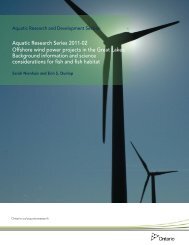Ontario's Natural Heritage Areas - Ministry of Natural Resources
Ontario's Natural Heritage Areas - Ministry of Natural Resources
Ontario's Natural Heritage Areas - Ministry of Natural Resources
Create successful ePaper yourself
Turn your PDF publications into a flip-book with our unique Google optimized e-Paper software.
The Crown, in Right <strong>of</strong> Canada, owns all land<br />
including the sea or lake bed and its subsoil, within<br />
a National Marine Conservation Area. Private lands<br />
and interests are acquired by negotiated settlement,<br />
and where appropriate term interests are allowed<br />
to expire. When a new NMCA is established in<br />
conjunction with the settlement <strong>of</strong> land claims, the<br />
final boundaries, as well as harvesting rights and<br />
involvement <strong>of</strong> Aboriginal peoples in planning and<br />
management, are proposed in legislation according<br />
to the terms <strong>of</strong> the land claim agreement. In the<br />
interim, the area may be set aside as a National<br />
Marine Conservation Area Reserve under the<br />
Canada National Marine Conservation <strong>Areas</strong> Act<br />
and traditional hunting, fishing, and other marine<br />
resource-based activities by entitled Aboriginal<br />
peoples are permitted to continue (Government <strong>of</strong><br />
Canada, 2002; Parks Canada, 1994:52).<br />
In addition to natural features, National Marine<br />
Conservation <strong>Areas</strong> can contain significant cultural<br />
resources that are managed according to the Cultural<br />
Resource Management Policy (Parks Canada,<br />
1994:53). Additional legislation used to govern<br />
NMCAs include the National Parks Act and the<br />
Species at Risk Act. Within Canada, a number <strong>of</strong> other<br />
marine protected areas are managed through Parks<br />
Canada and Environment Canada, namely Oceans Act<br />
Marine Protected <strong>Areas</strong> (MPAs) (see Section 5.7 on<br />
page 138) and Marine Wildlife <strong>Areas</strong> (see Section 5.8<br />
on page 140), respectively. A federal marine protected<br />
areas strategy has been developed to clarify the roles<br />
and responsibilities <strong>of</strong> each government agency,<br />
establish a more systematic approach to planning<br />
and establishment, enhance collaboration, increase<br />
awareness, and link to continental and global marine<br />
networks (DFO, 2005).<br />
Protection Goal and/or Objectives<br />
A National Marine Parks Policy was published in 1986<br />
and later revised as a National Marine Conservation<br />
<strong>Areas</strong> Policy (Parks Canada, 1994:46). The long-term<br />
goal <strong>of</strong> the National Marine Conservation <strong>Areas</strong><br />
Policy is to represent each <strong>of</strong> Canada’s 29 marine<br />
natural regions in the National Parks system. The<br />
principal objective is “…to protect and conserve<br />
for all time National Marine Conservation <strong>Areas</strong> <strong>of</strong><br />
Canadian significance that are representative <strong>of</strong> the<br />
country’s ocean environments and the Great Lakes,<br />
and to encourage public understanding, appreciation<br />
and enjoyment <strong>of</strong> this marine heritage so as to leave<br />
it unimpaired for future generations” (Duffus and<br />
Dearden, 1993; Parks Canada, 1994:49). In addition,<br />
objectives <strong>of</strong> National Marine Conservation <strong>Areas</strong><br />
include to:<br />
• Represent oceanic and Great Lakes environment<br />
diversity.<br />
• Maintain life support systems and ecological<br />
processes.<br />
• Preserve biodiversity.<br />
• Act as ecologically sustainable use models.<br />
• Promote ecological research and monitoring.<br />
• Protect endangered species and their habitats.<br />
• Protect cultural resources.<br />
• Provide marine areas interpretation for the<br />
purpose <strong>of</strong> conservation, education, and visitor<br />
enjoyment (Yurick and Mageau, 2006).<br />
Selection Criteria<br />
Given that each situation is unique, steps used to<br />
create a National Marine Conservation Area reflect<br />
individual circumstances. The normal sequence is to:<br />
• Identify representative marine areas.<br />
• Select a potential National Marine Conservation<br />
Area.<br />
• Assess the National Marine Conservation Area<br />
feasibility.<br />
• Negotiate a National Marine Conservation Area<br />
agreement.<br />
• Establish the new National Marine Conservation<br />
Area in legislation (Parks Canada, 2006a).<br />
The following criteria are considered when identifying<br />
potential NMCAs:<br />
• Geologic features (i.e. cliffs, beaches, islands, and<br />
underwater troughs or basins).<br />
• Marine features (i.e. tides, ice, current, and<br />
salinity).<br />
• Marine and coastal habitats (i.e. wetlands,<br />
estuaries, and protected areas).<br />
• Biology (i.e. plants, fish, seabirds, and mammals).<br />
• Archaeological and historic features (Parks<br />
Canada, 2006a).<br />
121 Ontario’s <strong>Natural</strong> <strong>Heritage</strong> <strong>Areas</strong>

















